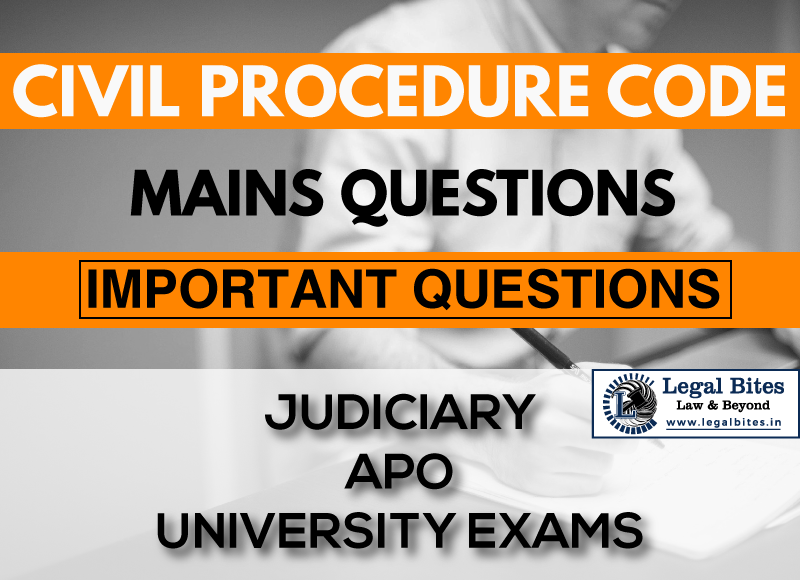Explain and illustrate the rule relating to joinder of plaintiff and defendants in a civil suit.
Find the answer to the mains question only on Legal Bites.;

Question: Explain and illustrate the rule relating to joinder of plaintiff and defendants in a civil suit. [UPJS 2000]Find the answer to the mains question only on Legal Bites. [Explain and illustrate the rule relating to joinder of plaintiff and defendants in a civil suit.]AnswerThe Joinder of plaintiffs and defendants in a civil suit refers to the legal principle that governs the inclusion of multiple parties on either side of a dispute. The Code of Civil Procedure (CPC) provides...
Question: Explain and illustrate the rule relating to joinder of plaintiff and defendants in a civil suit. [UPJS 2000]
Find the answer to the mains question only on Legal Bites. [Explain and illustrate the rule relating to joinder of plaintiff and defendants in a civil suit.]
Answer
The Joinder of plaintiffs and defendants in a civil suit refers to the legal principle that governs the inclusion of multiple parties on either side of a dispute. The Code of Civil Procedure (CPC) provides provisions and rules for determining when and how plaintiffs and defendants can be joined in a civil suit. Let's explore these provisions in detail:
A. Joinder of Plaintiffs:
According to Order 1, Rule 1 of the CPC, any number of plaintiffs can join together in a single suit if they have a common question of law or fact arising out of the same transaction or series of transactions. This rule allows individuals or entities with similar claims against the same defendant to join their causes of action in one suit, promoting judicial efficiency and avoiding multiple and separate proceedings.
The key requirements for the joinder of plaintiffs are:
a) Common question of law or fact: The claims of the plaintiffs must involve a common question of law or fact. This means that the issues to be determined by the court should be common to all the plaintiffs.
b) Same transaction or series of transactions: The claims of the plaintiffs should arise out of the same transaction or series of transactions. This ensures that the claims are sufficiently related and can be conveniently and effectively adjudicated in a single suit.
For example, in a case where multiple individuals have suffered injuries in a road accident caused by the same defendant, all the injured parties can join as plaintiffs in a single suit. Their claims arise from the same transaction (the accident) and involve common questions of fact (such as the cause of the accident and the extent of the injuries).
B. Joinder of Defendants:
The CPC also allows for the joinder of multiple defendants in a civil suit. Order 1, Rule 3 states that where multiple persons are liable or jointly interested in the same cause of action, they can be joined as defendants in one suit. This rule enables the efficient resolution of disputes involving multiple parties who share responsibility for the alleged wrongdoing or who have a common interest in the subject matter of the litigation.
The requirements for the joinder of defendants are:
a) Liability or joint interest: The defendants must be liable or jointly interested in the same cause of action. This means that they must have a shared responsibility or legal obligation arising from the same set of facts or circumstances.
b) Efficient adjudication: The joinder of defendants should facilitate the fair and efficient adjudication of the dispute, avoiding the risk of inconsistent judgments or separate proceedings.
For instance, in a case where a building collapses due to the negligence of the construction company, the owner of the building, the architects, and the contractors involved in the construction can all be joined as defendants in one suit. They share liability for the collapse and have a joint interest in the resolution of the claims against them.
It's important to note that the court has the power to permit or direct the addition or subtraction of parties at any stage of the proceedings if it deems it necessary for the complete and effective adjudication of the dispute (Order 1, Rule 10). This power ensures that all necessary parties are included and that the court's decision is comprehensive and binding on all interested parties.
In summary, the CPC allows for the joinder of plaintiffs and defendants in a civil suit when there is a common question of law or fact arising out of the same transaction or series of transactions. Joinder of plaintiffs promotes efficiency by consolidating related claims, while joinder of defendants enables the resolution of disputes involving multiple parties with shared liability or joint interest. The court has the power to add or remove parties to ensure a complete and effective adjudication of the matter.
Important Mains Questions Series for Judiciary, APO & University Exams
- CPC Mains Questions Series: Important Questions Part – I of X
- CPC Mains Questions Series: Important Questions Part – II of X
- CPC Mains Questions Series: Important Questions Part – III of X
- CPC Mains Questions Series: Important Questions Part – IV of X
- CPC Mains Questions Series: Important Questions Part – V of X
- CPC Mains Questions Series: Important Questions Part – VI of X
- CPC Mains Questions Series: Important Questions Part – VII of X
- CPC Mains Questions Series: Important Questions Part – VIII of X
- CPC Mains Questions Series: Important Questions Part – IX of X
- CPC Mains Questions Series: Important Questions Part – X of X


